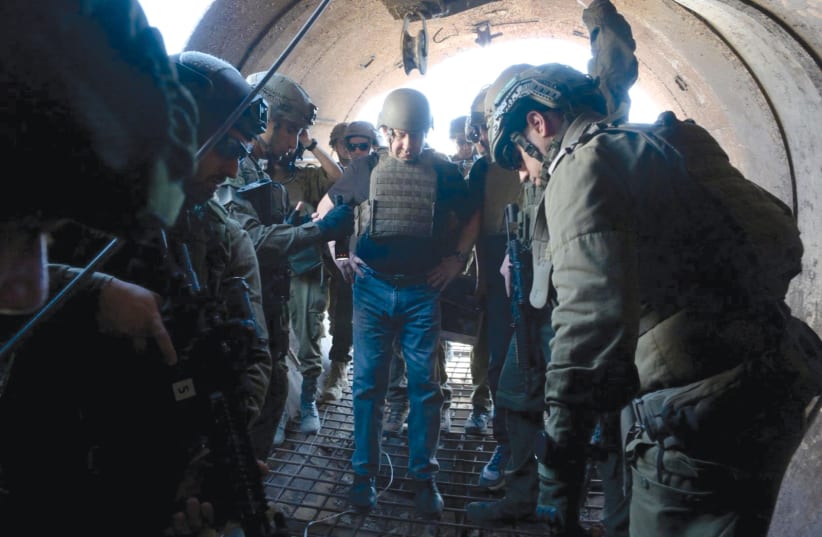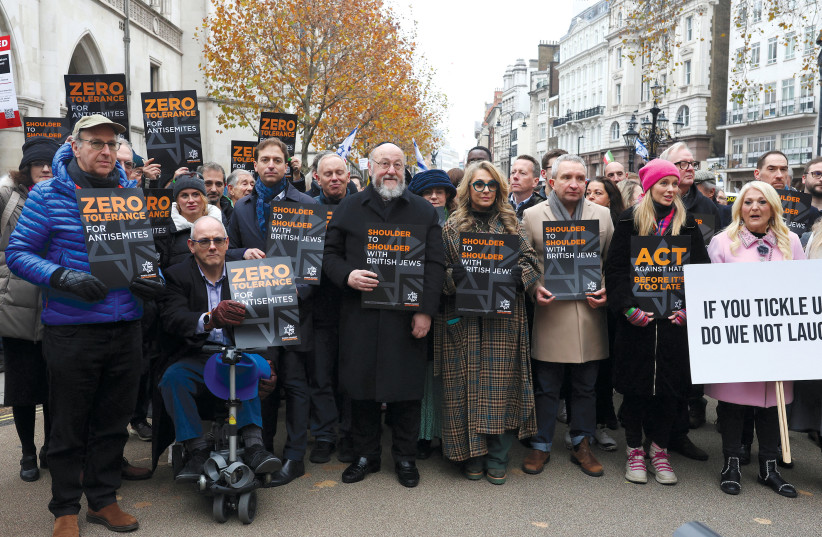Stated briefly, Israel’s war objectives as originally articulated by Prime Minister Benjamin Netanyahu, government ministers, and IDF commanders are to destroy Hamas and ensure the safe return of the hostages snatched from Israel on October 7. Political pressures have subsequently led to discussion about the order of priority of those objectives – in fact, the priority may need to alter in the face of changing circumstances – but nothing can alter the vital necessity of achieving both.
Even at this early stage in Israel’s campaign, there is a growing realization that by the time the IDF has succeeded, a plan for Gaza’s future governance must have been developed, agreed upon by those involved, and be ready for implementation.
On November 2, the Reuters news agency, citing authoritative sources, reported that the US and Israel were exploring options for the future of the Gaza Strip, including a possible multinational force to keep the peace until a more stable leadership is established. Such a scenario builds on US Secretary of State Antony Blinken’s concept, laid out during a recent visit to Israel. He said that he understood that Israel did not want to control Gaza, and he believed that a revitalized Palestinian Authority (PA) should eventually be in charge of the territory.
On November 6, both the rumored US-Israel negotiations and Blinken’s suggestion were apparently nullified. In a TV interview, Netanyahu said for the first time: “Israel will, for an indefinite period, have the overall security responsibility because we have seen what happens when we do not have it.”
His statement was as surprising for what he said as for what he omitted. He seemed to be saying that IDF forces would be stationed in Gaza for an indefinite period after the fighting. The conclusion that some commentators jumped to – that Israel was seeking to repossess the Strip – arose because of what Netanyahu did not say on that occasion. He omitted any indication of how he saw Gaza being administered post-Hamas, and by whom. He said nothing about who should be responsible for redeveloping Gaza City, for housing the displaced people returning to their home areas, for administering the essential services.
In subsequent media interviews, Netanyahu fleshed out his original remark. He made it clear that Israel did not plan to repossess Gaza nor to administer it, but also that he did not believe that the PA was a suitable body to take over the Strip after the war. He listed his reasons: The PA supported antisemitism; its “pay for slay” policy rewarded terrorists and their families for attacking Israeli civilians; its school textbooks taught pupils to hate Israel. Moreover, the PA refused to condemn the Hamas pogrom of October 7.
Repeatedly stating that the IDF must have permanent security control over Gaza, Netanyahu supported the idea of a newly constructed Palestinian government, bypassing the PA, taking over civilian control of the area. “We need a different authority, a different administration,” he told NBC. In a CNN interview, he said: “It has to be a reconstructed civilian authority. There has to be something else [other than the PA], otherwise we are just falling into that same rabbit hole.”
It is doubtful whether Netanyahu’s words will shift current Washington thinking. November 8 saw two statements from the US on the subject. John Kirby, US National Security Council spokesperson, acknowledged that the IDF was likely to remain in post-war Gaza for a period.
“It’s certainly plausible,” he said, “that for at least some period of time, Israeli defense forces are still going to be in Gaza to manage the immediate aftermath [of the war] and the security situation. But it shouldn’t be the long-term solution. It should not be about the IDF reoccupation of Gaza as a long-term governance solution.”
Speaking in Japan on the same day, Blinken, while acknowledging that “some transition period” might be needed at the end of the conflict, strongly advocated uniting Gaza and the West Bank after the war, and a PA-led Palestinian government to administer the Strip, as a step toward Palestinian statehood and a two-state solution. “We’re very clear on no reoccupation,” he said.
A few weeks into the war, the Washington Institute published a thoughtful analysis of what might follow an Israeli victory over Hamas. As a starting point, they acknowledged that it would be a mistake for Israel, having destroyed Hamas, to leave Gaza as an ungoverned space without a clear sense of what comes next. They insisted that the US and others must ensure that a plan is ready to be implemented once the IDF withdraws. What the institute did not consider was Netanyahu’s latest proposal – that the IDF might actually remain in place to guarantee that the Strip no longer posed any sort of security threat to Israel.
The idea of a Gaza administered under some as yet undefined group or consortium, with the IDF as its security force, bristles with difficulties and is almost certainly a non-starter. Nor could Blinken’s idea of the PA taking over the administration of Gaza work, with the PA in its present condition.
The PA is currently riddled with corruption and inefficiency. President Mahmoud Abbas, who is scarcely capable of controlling Areas A and B of the West Bank nominally under his control, is profoundly unpopular with the Palestinian public. In the most recent poll of Palestinian opinion, nearly 80% said he should step down. An essential prerequisite before Blinken’s ideas could be put into effect would be meaningful, substantive PA reform. Without obvious and significant changes to its administrative structure and methods of operation, neither local Palestinians nor international donors would have confidence in its ability to extend its authority to Gaza.
What a Gaza Interim Administration needs in the post-Hamas war era
The Washington Institute hypothesized that a proposed Gaza Interim Administration (GIA) should have three main components: a civilian administration; a law enforcement system; and an international coalition for reconstruction and development.
They believe that the civilian administration of post-Hamas Gaza should be led and run by Palestinians. The departments of a fully functioning local government – health, education, transportation, judiciary, social welfare – should, they maintain, be operated by a mix of technocrats and administrators from Gaza, the West Bank, and the Palestinian diaspora.
They envisage public safety and law enforcement being directed by a consortium of those Arab states that have reached peace or normalization agreements with Israel. Only those states, they opine, would have Israel’s confidence, which is essential for the effort to succeed.
They suggest that a new Arab-run agency responsible for repair, reconstruction, and development should be established. Billions of dollars would be needed to reconstruct Gaza City and to fund projects such as creating a new Gaza port and building new industrial zones to provide employment options.
Finally, the Washington Institute believe that while Arab administrators, officers, and officials, obviously including Palestinians, should take the lead in all these efforts, the US and other supporters of a peaceful, constructive future for Palestinians would have a vital role to play in conceiving the plans and in supporting those entrusted to carry them forward.
Whether the ideas put forward by the Washington Institute come to fruition or others, perhaps more radical, emerge, how Gaza is to be governed after the IDF has achieved its victory over Hamas clearly requires urgent and detailed consideration. Diplomatic efforts, led by the US, must be initiated as soon as possible, aimed at establishing an effective mechanism for planning Gaza’s post-war future.
And indeed, reports are surfacing which indicate that the US and its European allies are pushing a plan to deploy an international peacekeeping force in the Gaza Strip after the war. Israel is reported to be highly skeptical of such a plan, and certainly large questions remain about whether it would be workable in Gaza. But it is thought that considering what could follow the war might hasten its end.
The discussions, undertaken on the sidelines of the UN Security Council, are in their early stages. One option under consideration would involve an expanded role for the UN Truce Supervision Organization, first established in 1949 to help implement armistice agreements between Palestinian Arabs and Israel. The idea of Israel agreeing to any such proposal is remote, given the ineffectiveness of such UN interventions in the past and the generally hostile attitude of the UN toward Israel, from the secretary-general down.
Israel is far more likely to want any armed presence on the ground made up of Israel-friendly states, but the word is that for the moment Arab countries remain reluctant to discuss plans in detail.
Khaled al-Hroub is a professor at Northwestern University in Qatar. “It’s extremely difficult to think of the endgame,” he said. “But much depends on the final outcome of the war and the degree to which Hamas is weakened.”
Prime Minister Netanyahu has reiterated Israel’s intention on that score on numerous occasions: Hamas is to be destroyed. Stated baldly, that aim may be easier said than done. Political ideas cannot be destroyed, and doubtless Hamas-inspired extremists will continue to advocate the elimination of Israel come hell or high water. In practical terms, therefore, Israel’s aim must be to remove the Hamas organization as the governing authority in Gaza, and with it its hate-inspired control of the social and educational systems. In its place, all efforts must be devoted to devising an alternative form of Palestinian-led governance acceptable to both Palestinian and world opinion. ■
The writer’s latest book is Trump and the Holy Land: 2016-2020. Follow him at: www.a-mid-east-journal.blogspot.com

